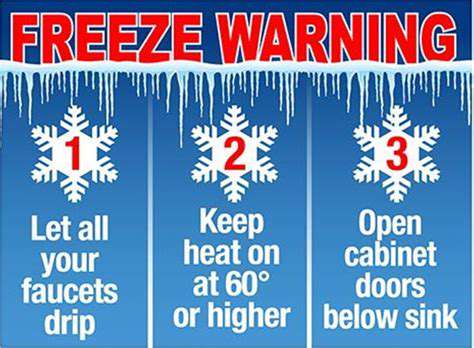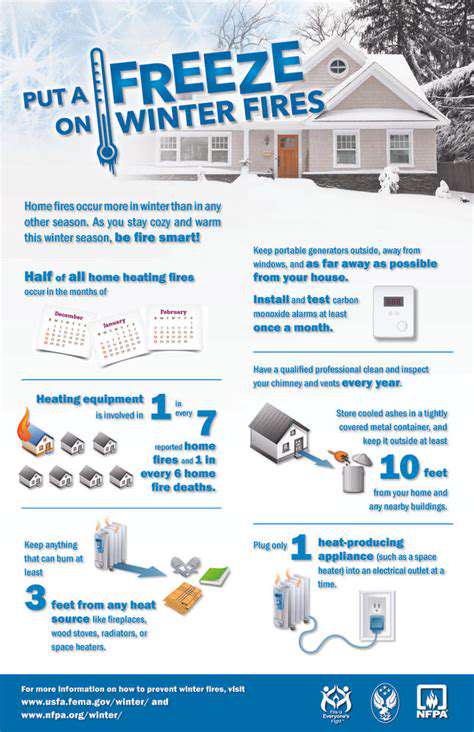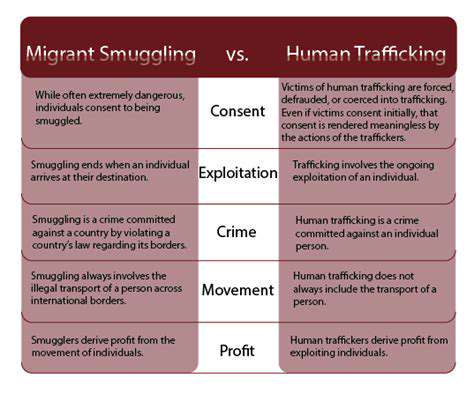Freeze Warning Alert: How to Prepare and Stay Safe in Cold Conditions
Understanding the Freeze Warning
When meteorologists issue a freeze warning, they're predicting temperatures will plummet below 32°F (0°C), creating hazardous conditions for vegetation and infrastructure. Unlike a simple cold spell, this official alert signals imminent danger to sensitive plants, agricultural crops, and exposed plumbing systems. The distinction between a routine cold front and an actual freeze warning could mean the difference between minor discomfort and serious property damage.
Many homeowners underestimate the severity of freeze warnings until they're facing burst pipes or dead landscaping. The warning specifically indicates that temperatures will reach levels capable of causing ice formation in unprotected water systems and cellular damage to plant tissues. This isn't just about needing an extra sweater - it's about preventing potentially expensive repairs and losses.
Protecting Your Plants and Property
Vegetation reacts dramatically to subfreezing temperatures. Delicate annuals and tropical species can perish overnight when mercury drops too low. Practical protection methods include:- Wrapping shrubs in breathable fabric covers- Moving container plants to sheltered areas- Applying thick mulch around root systemsPipes demand equal attention, as just one night of freezing can lead to catastrophic leaks when thawing occurs. Homeowners should prioritize insulating exposed plumbing in crawl spaces, garages, and along exterior walls.
Preparing Your Home for Freezing Temperatures
Winterizing a residence requires systematic preparation. Start with these critical steps:1. Allow faucets to drip slightly to maintain water movement2. Open cabinet doors to circulate warm air around pipes3. Drain and disconnect garden hoses4. Apply insulating covers to outdoor spigotsThe basement and attic often harbor vulnerable plumbing that homeowners forget to protect. These hidden areas frequently become sources of major water damage when freezing occurs.
Understanding the Impact of Freeze Warnings
The ripple effects of freezing conditions extend far beyond individual properties. Agricultural sectors face devastating losses when crops freeze, potentially affecting food supplies and prices. Municipalities grapple with increased demands on emergency services as pipes burst and roads ice over. On a personal level, the financial impact of freeze-related damage can strain household budgets, with average pipe repair costs ranging from $500 to $3,000.
Staying Informed During a Freeze Warning
Modern technology offers multiple channels for receiving critical weather updates:- NOAA Weather Radio provides continuous alerts- Smartphone apps deliver push notifications- Local news stations offer detailed forecastsSetting multiple alerts ensures you won't miss warnings that could arrive overnight or during work hours. Pay particular attention to predicted temperature lows and the expected duration of freezing conditions, as these factors determine necessary protective measures.
Protecting Your Home and Property from the Cold
Protecting Your Pipes
Plumbing systems become particularly vulnerable when temperatures drop. Consider these protective strategies:- Install foam pipe insulation on all exposed lines- Apply thermostatically controlled heat tape to high-risk pipes- Seal foundation cracks that allow cold air infiltrationFor vacation homes or vacant properties, completely draining the water system may be the safest approach. Remember that a single burst pipe can release hundreds of gallons per hour, causing extensive structural damage.
Preparing Your Home's Exterior
Gutter maintenance becomes crucial in freezing conditions. Clogged gutters lead to ice dams, which force water under roofing materials. Schedule pre-winter gutter cleaning and consider installing heated gutter cables in problem areas. Roof snow removal should occur after every significant accumulation, using proper tools to avoid damaging shingles.
Protecting Your Landscaping
Different plant species require specific protection methods:- Wrap young trees with commercial tree wrap- Construct temporary burlap screens for wind protection- Water evergreens thoroughly before ground freezesApplying anti-desiccant sprays can help reduce moisture loss from evergreen foliage during cold, windy periods. Avoid pruning plants in fall, as this stimulates new growth vulnerable to winter damage.
Ensuring Appliance Functionality
Outdoor appliances need special attention:- Drain and winterize irrigation systems- Store gas grills with empty propane tanks- Cover air conditioning units with breathable materialsIndoor appliances located in unheated spaces (like basement freezers) may require supplemental insulation or small space heaters to maintain proper operating temperatures.
Securing Your Belongings
Winter weather can damage stored items in unexpected ways:- Use moisture absorbers in storage areas- Elevate cardboard boxes off concrete floors- Wrap fragile items in insulating materialsCheck weather stripping around doors and windows monthly, as compressed or worn seals allow heat loss and cold air infiltration.
Preparing for Power Outages
A comprehensive emergency kit should include:- Battery-powered or hand-crank radio- Multiple light sources (flashlights, lanterns)- Non-perishable food requiring no cooking- Backup power sources for medical equipmentFamilies with infants or elderly members should maintain a 72-hour supply of special needs items like formula, medications, or oxygen tanks.
Preparing Your Body for Cold Temperatures
Layering Is Key
Effective cold weather dressing follows the three-layer principle:1. Base layer (moisture-wicking synthetic or wool)2. Insulating layer (fleece or down)3. Shell layer (waterproof and windproof)Avoid cotton as a base layer - it retains moisture and accelerates heat loss. Adjust layers as activity levels change to prevent overheating and subsequent chilling from sweat accumulation.
Protecting Your Extremities
Frostbite typically attacks exposed skin and extremities first. Protect these vulnerable areas with:- Insulated, waterproof boots with thick soles- Mittens (warmer than gloves) with liner gloves- Balaclavas or scarves for face protectionFor outdoor workers or winter sports enthusiasts, chemical hand warmers provide supplemental heat in extreme conditions.
Hydration is Important
Cold weather dehydration occurs through:- Increased respiratory fluid loss- Reduced thirst response- Diuretic effect of caffeine/alcoholMonitor urine color - pale yellow indicates proper hydration, while dark yellow signals dehydration. Warm herbal teas and broth-based soups provide both fluids and electrolytes without the dehydrating effects of caffeine.
Understanding Your Limitations
Cold stress affects individuals differently based on:- Age (elderly and young children most vulnerable)- Medical conditions (especially circulatory issues)- Medication side effects- Acclimatization levelRecognize warning signs like uncontrolled shivering, slurred speech, or loss of coordination, which indicate dangerous hypothermia.
Monitoring Your Body Temperature
Core temperature regulation requires:- Frequent breaks in heated areas- Dry clothing changes when damp- Calorie-dense snacks for fuelDigital thermometers can monitor body temperature during prolonged exposure. Any reading below 95°F (35°C) requires immediate medical attention.
Food and Fuel
Cold weather increases caloric needs through:- Shivering thermogenesis- Increased metabolic demands- Heavy clothing weightFocus on complex carbohydrates and healthy fats that provide sustained energy. Portable snacks like trail mix, energy bars, and cheese sticks offer convenient nutrition during outdoor activities.
Appropriate Gear and Clothing
Specialized winter gear includes:- Insulated, waterproof footwear with traction- Goggles for windy conditions- Reflective materials for low-light visibilityInvest in quality items rather than multiple cheap pieces - proper gear lasts longer and performs better. Break in new boots before winter to prevent blisters and discomfort.

Emergency Preparedness During a Freeze Warning

Understanding the Importance of Emergency Preparedness
Freeze-related emergencies often compound with other winter hazards:- Power failures from ice-laden lines- Transportation disruptions- Heating system failuresDeveloping contingency plans for these scenarios reduces panic and improves outcomes. Maintain printed copies of emergency contacts and procedures, as digital devices may fail during severe weather.
Developing a Fire Evacuation Plan
Winter fire risks increase due to:- Space heater use- Fireplace accidents- Overloaded electrical circuitsPractice evacuation routes with all household members, including alternative paths if primary exits become blocked. Designate a sheltered outdoor meeting place protected from wind and precipitation.
Essential Supplies and Resources
Beyond basic emergency kits, winter-specific supplies should include:- Sand or non-clumping kitty litter for traction- Snow removal tools- Extra blankets and sleeping bags- Portable jump starter for vehiclesRotate perishable items like medications and batteries every six months. Keep vehicle gas tanks at least half full to prevent fuel line freezing.
Communication and Contact Procedures
Establish multiple communication methods:- Text messaging (works when calls fail)- Social media check-in systems- Neighborhood communication treesProgram emergency contacts into all family members' phones and teach children how to dial 911. Identify community resources like warming centers before they're needed.
Read more about Freeze Warning Alert: How to Prepare and Stay Safe in Cold Conditions
Hot Recommendations
- Hawks vs Hornets: NBA Game Preview, Key Players & Tactical Analysis
- Tornado Watch vs Warning: What’s the Difference and How to Stay Safe
- Alexandra Daddario: Hollywood Career, Iconic Roles & Upcoming Projects
- Wombats in Australia: Fascinating Facts, Conservation Efforts & Where to See Them
- St. Patrick’s Day 2025: History, Festivities & Modern Celebrations
- Fabian Schmidt: Profile, Career Impact & Notable Achievements
- Alex Consani: Profile, Career Highlights, and Notable Achievements
- Vivian Wilson: Profile, Career Milestones & What’s Next
- Harriet Hageman: Political Profile and Impact on National Policy
- Bryant University Basketball: Rising Stars and Season Highlights











